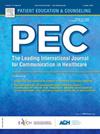Effects of an eLearning course for patients on osteoarthritis knowledge and pain self-efficacy in people with hip and/or knee osteoarthritis: A randomised controlled trial
IF 2.9
2区 医学
Q2 PUBLIC, ENVIRONMENTAL & OCCUPATIONAL HEALTH
引用次数: 0
Abstract
Objective
Evaluate a knee/hip osteoarthritis eLearning course for patients.
Methods
Randomised controlled trial. 124 community volunteers with knee/hip osteoarthritis were randomised to either i) a 4-week self-directed eLearning or ii) an electronic osteoarthritis pamphlet (control). Primary outcomes: change in knowledge (Osteoarthritis Knowledge Scale (OAKS)) and pain self-efficacy (Arthritis Self-Efficacy Scale (ASES pain subscale)) over 5 weeks. Secondary outcomes: fear of movement, exercise self-efficacy, osteoarthritis illness perceptions, physical activity levels, and use of physical activity/exercise, weight loss, pain medication, and health professional care seeking to manage joint symptoms.
Results
117(94 %) participants (mean (SD) age, 67.1(8.8) years; 91(77.8 %) female) provided 5-week primary outcomes. At 5-weeks, eLearning group showed greater improvements in osteoarthritis knowledge (mean difference 5.3(95 % CI 2.5,8.2), < 0.001), which was sustained at 13-weeks (4.6(2.1,7.0), < 0.001). There were no between-group differences in pain self-efficacy. Between-group differences for exercise self-efficacy and osteoarthritis illness perceptions at 5-weeks, and fear of movement and use of weight loss to manage joint symptoms at 13-weeks, favoured eLearning group.
Conclusions
eLearning produced immediate and sustained improvements in osteoarthritis knowledge but not pain self-efficacy compared to a typical osteoarthritis education intervention (information pamphlet).
Practice implications
Self-directed interactive eLearning is an effective method to educate patients about hip/knee osteoarthritis and its management.
髋关节和/或膝关节骨关节炎患者在线学习课程对骨关节炎知识和疼痛自我效能的影响:一项随机对照试验
目的评价膝/髋骨关节炎患者的在线学习课程。方法:随机对照试验。124名患有膝/髋骨关节炎的社区志愿者被随机分为两组:1)为期4周的自我指导电子学习;2)电子骨关节炎小册子(对照组)。主要结局:知识(骨关节炎知识量表(OAKS))和疼痛自我效能(关节炎自我效能量表(ASES疼痛亚量表))在5周内的变化。次要结局:运动恐惧、运动自我效能、骨关节炎疾病认知、身体活动水平、身体活动/运动的使用、体重减轻、止痛药治疗和寻求健康专业护理来控制关节症状。结果117(94 %)名参与者(平均(SD)年龄67.1(8.8)岁;91例(77.8% %)女性)提供了5周的主要结局。在5周时,eLearning组在骨关节炎知识方面表现出更大的改善(平均差异为5.3(95 % CI 2.5,8.2), <; 0.001),并持续到13周(4.6(2.1,7.0),<; 0.001)。疼痛自我效能感组间无差异。5周时运动自我效能和骨关节炎疾病认知的组间差异,以及13周时运动恐惧和使用减肥来控制关节症状的组间差异。结论与典型的骨关节炎教育干预(信息小册子)相比,学习可以立即和持续地改善骨关节炎知识,但不能改善疼痛自我效能感。实践意义:自我指导的交互式电子学习是对患者进行髋关节/膝关节骨关节炎及其治疗教育的有效方法。
本文章由计算机程序翻译,如有差异,请以英文原文为准。
求助全文
约1分钟内获得全文
求助全文
来源期刊

Patient Education and Counseling
医学-公共卫生、环境卫生与职业卫生
CiteScore
5.60
自引率
11.40%
发文量
384
审稿时长
46 days
期刊介绍:
Patient Education and Counseling is an interdisciplinary, international journal for patient education and health promotion researchers, managers and clinicians. The journal seeks to explore and elucidate the educational, counseling and communication models in health care. Its aim is to provide a forum for fundamental as well as applied research, and to promote the study of organizational issues involved with the delivery of patient education, counseling, health promotion services and training models in improving communication between providers and patients.
 求助内容:
求助内容: 应助结果提醒方式:
应助结果提醒方式:


